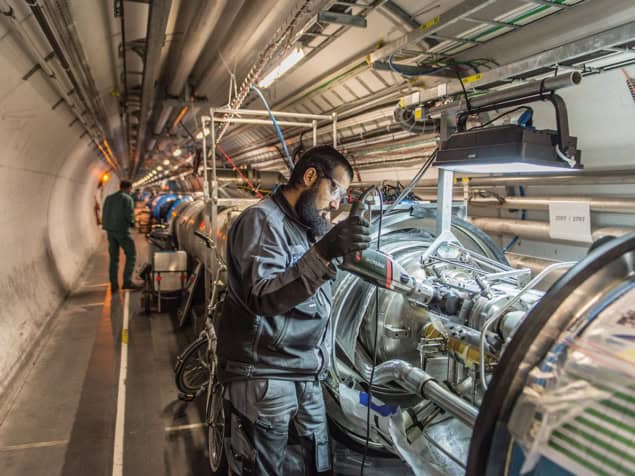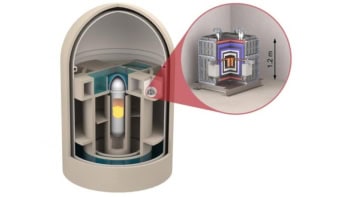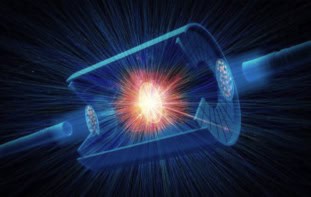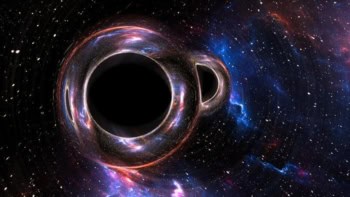Following a two-year shutdown for maintenance and upgrades, Ned Stafford looks at how the LHC has been improved to allow researchers to hunt for new particles

CERN’s 27 km-circumference Large Hadron Collider (LHC) – the world’s most powerful particle accelerator – is expected to be fully operational once again next year, allowing physicists to resume experiments after a two-year shutdown for maintenance and upgrading. CERN scientists hope that the upgrade will enable the LHC to operate with collision energies of 13 TeV, just short of its design energy of 14 TeV. This would open a new window for discoveries, including studying the Higgs boson in greater detail and hunting for “supersymmetric” particles. Indeed, the upgrade is expected to improve the LHC’s ability to detect heavy new particles by a factor of two, while the number of Higgs bosons produced will increase by an order of magnitude in total.
The LHC upgrade – costing SwFr,150m ($160m) – was completed in June, and is being followed by a step-by-step restarting and testing process that will last into early 2015. The upgrade will allow the LHC to operate at higher energies and with beams that are squeezed into a smaller area as they pass through the detectors to increase the collision rate. “There is a general sense of anticipation – the excitement is building,” says theoretical physicist John Ellis of King’s College London, who is also based at CERN. “I am personally looking forward to a lot of fun in the next two to three years and, as data come out, raking through the coals and seeing if there are any gems.”
Following a hugely successful run lasting three years, the LHC, which accelerates and collides protons with antiprotons, was shut down for maintenance in February 2013. The LHC had been operating with collision energies of around 7 TeV – or 3.5 TeV per beam. Despite not reaching its full design energy during that first run, in July 2012 scientists were still able to announce that they had detected the Higgs boson, which was first theorized in 1964. CERN’s successful detection was capped last year when François Englert and Peter Higgs were awarded the 2013 Nobel Prize for Physics.
But the rest of CERN’s accelerator complex has been receiving plenty of attention too during the current shutdown, with maintenance and upgrading work also being carried out on the “injector complex” – the chain of smaller accelerators that feed the LHC with particles. The starting point for protons at CERN is linear accelerator 2, or “Linac 2”, which sends protons into the Proton Synchrotron Booster (PSB) that in turn injects protons into the Proton Synchrotron (PS). The next and final step before delivery of protons to the LHC is the 7 km Super Proton Synchrotron (SPS), which was first switched on in 1976. “I like to compare it to changing gears on a car,” says Ellis.
The long list of maintenance and upgrading tasks that CERN completed during the 16-month shutdown include making 1695 openings and re-closures of the vacuum enclosure in between the LHC magnets that include the vacuum and helium pipes. Engineers made 400,000 electrical-resistance measurements as well as improving the 13 kA circuits in the 16 main electrical-feed boxes. These circuits connect the warm current leads from the power supplies with the superconducting leads that feed the current to the magnets. The upgrade also involved completely replacing four quadrupole magnets and 15 dipole magnets that looked suspect during testing.
But the biggest portion of work, according to Mike Lamont, head of the accelerator operation group at CERN, was the consolidation of more than 10,000 “splices” between superconducting magnets. These splices are essentially “superconducting cable joints” with six splices per interconnect. “This was a huge job,” Lamont says, pointing out that the consolidation included soldering shunts on the splices to ensure electrical continuity and installing improved electrical insulation, which also acts as a mechanical restraint to limit stresses and deformations.
The maintenance work was complete in June, with the restarting process for the LHC beginning shortly afterwards. At the time, Frédérick Bordry, CERN’s director for accelerators and technology, described the LHC as “coming out of a long sleep after undergoing an important surgical operation”. On 2 June, the PSB was restarted followed by the PS on 18 June. In July, powering tests began at the SPS and the physics programme covering CERN’s antimatter experiments is expected to resume in October.
Lamont says that the LHC is having to undergo months of intensive testing to ensure that the upgrade was successful before the full physics programme at the LHC can resume next year. Testing includes putting a current through each of the LHC’s eight sections and Lamont adds that all eight sections of the LHC should be cooled down by October to the operating temperature of around 2 K.
Lamont, however, hesitates to describe the LHC as new, but agrees that the LHC will have enhanced capabilities. “From a physics viewpoint, we are entering new ground,” he says. “It is a new frontier.”



